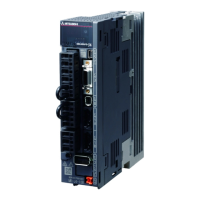
Do you have a question about the Mitsubishi Electric MELSERVO-J4 MR-J4 A Series and is the answer not in the manual?
| Series | MELSERVO-J4 |
|---|---|
| IP Rating | IP20 |
| Communication | CC-Link IE Field Network Basic, SSCNET III/H |
| Power Supply Voltage | 1-phase 200 V AC to 240 V AC, 3-phase 200 V AC to 240 V AC |
| Output Current | 0.1A to 55A |
| Applicable Motor Series | HG-RR, HG-JR |
| Safety Functions | STO (Safe Torque Off), SS1 (Safe Stop 1), SS2 (Safe Stop 2), SLS (Safely Limited Speed), SOS (Safe Operating Stop), SDI (Safe Direction), SBC (Safe Brake Control) |
| Rated Output | Up to 15kW |
| Feedback System | Incremental encoder, absolute encoder |
| Protection Features | Over-voltage, under-voltage, over-current |
| Ambient Operating Temperature | 0 to 55°C |
| Storage Temperature | -20 to 65°C |
| Ambient Humidity | Up to 90% (non-condensing) |
| Cooling Method | Natural air cooling |
Overview of the MR-J4 series servo amplifier's high performance, features, and control modes.
Illustrates the internal structure and signal flow of the servo amplifier for MR-J4-500A or less and MR-J4-700A.
Details the electrical and performance specifications for the MR-J4 series servo amplifiers.
Lists compatible rotary, linear, and direct drive servo motors for each MR-J4 servo amplifier model.
A comprehensive list of all functions available with the servo amplifier, with cross-references to detailed explanations.
Explains how to interpret the model name of the MR-J4 series servo amplifier.
Identifies and describes the physical parts and connectors of the MR-J4 servo amplifier.
Illustrates typical wiring diagrams showing how to connect auxiliary equipment to the servo amplifier.
Specifies required clearances for mounting the servo amplifier within a cabinet for proper ventilation.
Provides instructions on preventing foreign materials from entering the servo amplifier or cabinet.
Advises on managing encoder cable stress to avoid damage and ensure reliable operation.
Lists periodic inspection points for the servo amplifier and its connections.
Details the service life guidelines for key components like capacitors, relays, and cooling fans.
Explains the wiring for the main and control circuit power supplies, including safety precautions.
Provides examples of wiring digital I/O signals for different control modes.
Details the power supply connections and signal explanations for various terminals.
Describes the connector types and applicable wires for power supply connections.
Illustrates the pin assignments for various connectors on the servo amplifier.
Provides detailed explanations of input/output signals and their functions in different control modes.
Offers in-depth descriptions of signals for position, speed, and torque control modes.
Explains the SS1 function for forced stop deceleration and its connection.
Illustrates timing charts for alarm occurrences and their impact on servo operation.
Details various interfaces like USB, RS-422, and encoder connections.
Covers safety precautions and connection diagrams for servo motors with electromagnetic brakes.
Provides essential guidelines for proper grounding of the servo amplifier and servo motor.
Step-by-step guide for initial power-on and wiring checks.
Specific startup procedures for position control mode.
Specific startup procedures for speed control mode.
Specific startup procedures for torque control mode.
Explains the display unit, buttons, and operational modes of the servo amplifier.
An overview of all available parameters, categorized by type.
Detailed descriptions and settings for each parameter, including control mode applicability.
Details various gain adjustment methods like auto tuning and manual adjustment.
Explains the one-touch tuning function, its parameters, and operating procedures.
Describes the auto tuning modes, their procedures, and conditions for optimal performance.
Provides guidelines for manual gain adjustment using specific parameters.
Explains the 2 gain adjustment modes for multi-axis interpolation operations.
Details various filters like low-pass and resonance suppression filters.
Describes how to switch gains based on operating conditions for improved stability.
Explains functions like vibration tough drive and instantaneous power failure tough drive.
Lists all possible alarms, their causes, stop methods, and deactivation procedures.
Lists all possible warnings, their causes, and stop methods.
Provides dimensional drawings and mounting information for various MR-J4 servo amplifier models.
Shows the dimensions and specifications for various connector types.
Details the electronic thermal protection and overload protection mechanisms of the servo amplifier.
Provides data on power supply capacity and heat generated by servo amplifiers and servo motors.
Explains the dynamic brake operation, coasting distance calculation, and permissible load ratios.
Shows graphs indicating the bending life of various cables used with the servo system.
Lists the inrush current values for main and control circuits at power-on.
Details available cable and connector options, including IP ratings.
Explains combinations of regenerative options, their power, and selection criteria.
Provides information on the FR-BU2 brake unit, its selection, and parameter settings.
Details the FR-RC power regenerative converter, its selection, and connection examples.
Explains the FR-CV power regenerative common converter, its model, selection, and restrictions.
Describes the usage, terminal labels, and dimensions of the MR-TB50 junction terminal block.
Details the software MR Configurator2, its specifications, system requirements, and connection.
Information on the MR-BAT6V1SET battery for absolute position detection systems.
Provides guidance on selecting appropriate wires and crimp terminals for various connections.
Lists recommended circuit breakers, fuses, and magnetic contactors for power supply protection.
Explains the advantages and installation of power factor improving DC reactors.
Describes the benefits and connection of power factor improving AC reactors.
Suggests suitable relays for digital input and output interfaces.
Covers methods for reducing noise transmitted through air and electric channels.
Provides guidance on selecting leakage current breakers based on calculated values.
Recommends EMC filters for compliance with EN standards and shows connection examples.
An overview of the absolute position detection system's features and purpose.
Lists the specifications for the battery and other components of the absolute position system.
Provides safety precautions and procedures for replacing the backup battery.
Details the steps for installing and removing the battery for the absolute position system.
Illustrates the standard connection of the positioning module, I/O, and servo amplifier.
Explains the function and application of signals related to ABS transfer.
Outlines the startup procedure for the absolute position detection system.
Describes the data transfer protocol for absolute position data.
Details the communication-based ABS transfer system, including commands and protocol.
Explains how to confirm absolute position data using MR Configurator2.
Overview of the STO function and its compliance with safety standards.
Defines safety terms related to the STO function, including stop categories.
Provides essential safety notes for installation and handling of components.
Identifies residual risks associated with the STO/EMG function and liability.
Lists the safety specifications, standards, and performance metrics for the STO function.
Provides information on maintenance and alarms for the Mitsubishi drive safety function.
Summary of maintenance information for the servo amplifier and safety logic unit.
Explains the function and states of STO/EMG signals and their corresponding wiring.
Illustrates connection examples for the STO function with external safety relays.
Provides guidelines for handling and transporting AC servo amplifier batteries according to UN regulations.
Details compliance with EMC and Low voltage directives for CE marking.
Confirms compliance with UL 508C and CSA C22.2 No.14 standards.
Lists the items included in the MR-J3-D05 safety logic unit package.
Defines safety terms related to STO and SS1 functions and emergency operations.
Provides essential safety notes for installation, repair, and service of the safety logic unit.
Outlines residual risks associated with STO/EMG functions and Mitsubishi's liability.
Shows the block diagram and operation sequence for the safety logic unit.

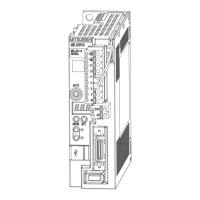

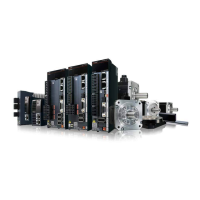

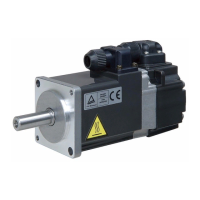
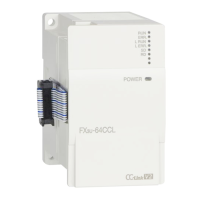
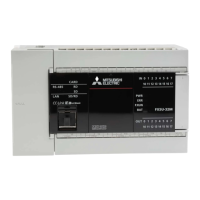
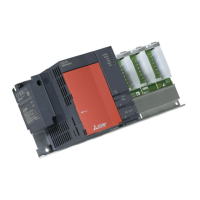
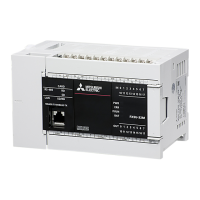


